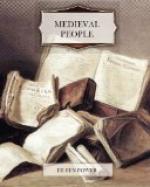garlands on their heads and banners and trumpets;
then the furriers apparelled in samite and scarlet
silk, with mantles of ermine and vair; then the
weavers richly bedight, and the ten master tailors
in white with crimson stars. Then the master
clothworkers passed, carrying boughs of olive
and wearing crowns of olive on their heads; then
the fustian makers in furred robes of their own
weaving, and the quilt makers with garlands of
gilt beads and white cloaks sewn with fleurs-de-lis,
marching two by two, with little children singing
chansonettes and cobles before them.
Then came the makers of cloth of gold, all in
cloth of gold, and their servants in cloth of
gold or of purple, followed by the mercers in
silk and the butchers in scarlet, the fish sellers
robed and furred and garlanded, and the master
barbers, having with them two riders attired
as knights-errant, and four captive damsels,
strangely garbed. Then came the glass-workers
in scarlet furred with vair, and gold-fringed hoods,
and rich garlands of pearls, carrying flasks and goblets
of the famous Venetian glass before them, and the
comb and lantern makers, with a lantern full of
birds to let loose in the Doge’s presence,
and the goldsmiths wearing wreaths and necklaces
of gold and silver beads and sapphires, emeralds,
diamonds, topazes, jacinths, amethysts, rubies, jasper,
and carbuncles. Master and servants alike were
sumptuously clad, and almost all wore gold fringes
on their hoods, and garlands of gilded beads.
Each craft was accompanied by its band of divers
instruments, and bore with it silver cups and
flagons of wine, and all marched in fair order,
singing ballads and songs of greeting, and saluted
the Doge and Dogaressa in turn, crying ’Long
live our lord, the noble Doge Lorenzo Tiepolo!’
Gild after gild they marched in their splendour,
lovely alike to ear and eye; and a week fled before
the rejoicings were ended and all had passed in procession.
Canale surpasses himself here, for he loved State
ceremonies; he gives a paragraph to the advance
of each gild, its salutation and withdrawal,
and the cumulative effect of all the paragraphs
is enchanting, like a prose ballade, with a repeated
refrain at the end of every verse.[9]
What, they lived once thus in Venice, where the merchants
were the
kings,
Where St Mark’s is, where the Doges used to
wed the sea with rings?
Listening to the magnificent salutation of the Doge by the priests of St Mark’s, ’Criste, vince, Criste regne, Criste inpere. Notre signor Laurens Teuples, Des gracie, inclit Dus de Venise, Dalmace atque Groace, et dominator de la quarte partie et demi de tot l’enmire de Romanie, sauvement, honor, vie, et victoire. Saint Marc, tu le aie,’[10] who, hearing, could have doubted that Venice, defier of Rome and conqueror of Constantinople, was the finest, richest, most beautiful, and most powerful city in the world?
But was she? Listen and judge.




